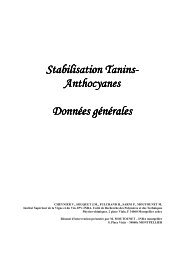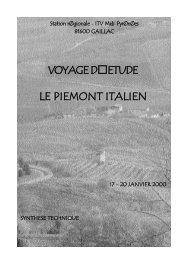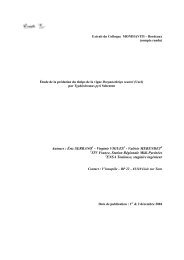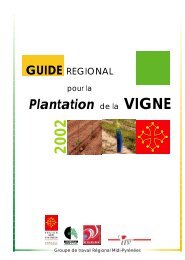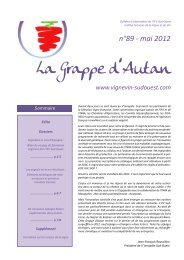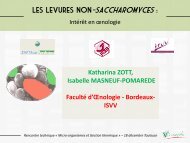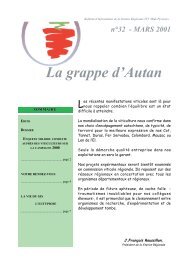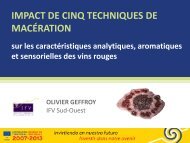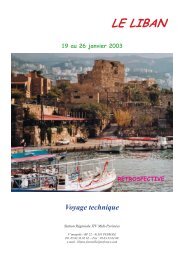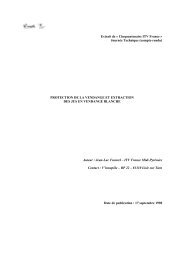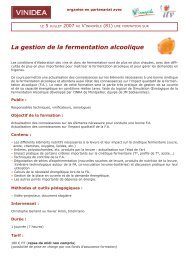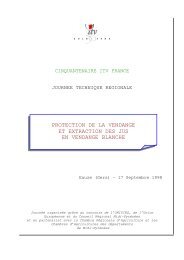Bioconversion de l'acide p-coumarique par Brettanomyces ...
Bioconversion de l'acide p-coumarique par Brettanomyces ...
Bioconversion de l'acide p-coumarique par Brettanomyces ...
You also want an ePaper? Increase the reach of your titles
YUMPU automatically turns print PDFs into web optimized ePapers that Google loves.
On the other hand, when the yeast cell walls were the adsorbent, experimentalresults were less reproducible. The interpretation of <strong>par</strong>eto graphs was moredifficult and all the factors seemed to affect the Qe.Nevertheless, it was possible to com<strong>par</strong>e the capacity of adsorption of PVPPand yeast extract. With the same concentration of each (3g/L), PVPP wasalways a better adsorbent than yeast extract. For instance, at 25 o C, themaximum loss of p-coumaric acid by adsorption was 69% ± 1% and 99.4 % ±8.4 respectively for 20 and 2.5 mg/L when the PVPP was the adsorbent whereasthe maximum loss of p-coumaric acid was 45% ± 12% and 72% ± 37% whenthe yeast cell walls were the adsorbent (respectively for 20 and 2.5 mg/L).,.4. CONCLUSIONThe p-coumaric acid showed different adsorption profiles on different yeastspecies. The brettanomyces sp. had a better adsorption potential of the p-coumaric acid than the saccharomyces sp. Because of its <strong>par</strong>tial adsorption onyeast, the p-coumaric acid present in wine cannot be transformed totally into 4-vinylphenol and 4-ethylphenol.The p-coumaric acid removal from the medium will avoid the horse sweat smellodours if a contamination occurs. Its adsorption on oenological components canbe a solution to avoid its bioconversion.The two adsorbent materials tested showed that the PVPP is a better adsorbentthan yeast cell walls of this acid in wine conditions. The non significanceeffects of the factors pH and ethanol concentration on the p-coumaricadsorption by PVPP was proved. On the other hand, increasing the temperaturefrom 25 to 35°C favoured the adsorption on PVPP. Finally, it was shown withPVPP, that it is possible to <strong>de</strong>crease drastically the p-coumaric acidconcentration in a synthetic wine medium.The p-coumaric acid adsorption on PVPP in true wine is being studied, as a firststep of industrial application.REFERENCES(1) P. Chatonnet, C. Viala, D. Dubourdieu. Am. J. Enol. Vitic. 48 (1997)443-448.(2) D. M. Goldberg, E. Tsang, A. Karumanchiri, G. J. Soleas. Am. J. Enol.Vitic. 49 (1998) 142-151.(3) P. Chatonnet, D. Dubourdieu, J.N. Boidron, M. Pons. J. Sc. of FoodAgric. 60(1992) 165-178.(4) L. Dias, S. Pereira-da-Silva, M. Tavares, M. Malfeito-Ferreira, V.Loureiro. Food Microbiol. 20(2003) 377–384.(5) D. Chassagne, M. Guillou-Benatier, H. Alexandre, A. Voilley. Foodchem. 91(2005)39-44(6) A. Morata, M.C. Gomez-Cordoves, J. Suberviola, B. Bartolomé, B.Colomo, J.A. Suárez. J. Agric. Food Chem. 51(2003) 4084-4088.(7) S. Razmkhab, A. Lopez-Toledano, J.M. Ortega, M. Mayen, J. Merida,M. Medina. J. Agric. Food Chem, 50(2002), 7432-7437.(8) D. Salameh, C. Brandam, W. Medawar, R. Lteif, P. Strehaiano. FoodChem.107(4)(2008) 1661-1667.



